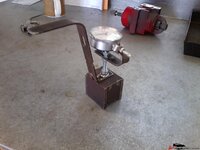JPhil
Huh?
I need to index my bellhousing for my new TKO600 with the engine in the car. Yeah it would have easier to do when the engine was out but oh well. My SFI rated bellhousing does not have an inspection cover to put a flywheel wrench on. Turning the engine over by the front pulley nut with a socket and big ass breaker bar is a real drag and always makes me nervous.
Gotta be a better way to turn the engine over by hand.
So I went to a starter & alternator rebuilder and got a junk starter motor for free to see if I could make one I can put a wrench on to turn over the engine by hand from below. Here's what I came up with:
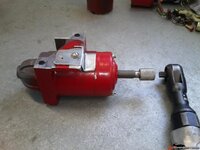
Started by stripping the guts out. I replaced the solenoid throwout & spring with a piece of 5/8" heater hose to keep the gear out permanently.
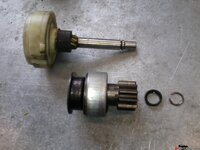
I cut off the commutator & armature by sawing opposite sides to the shaft & splitting it off with hammer & chisel.
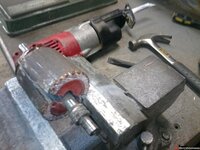
Fabbed up a planetary gear retainer & and a shaft end support bushing from some polyisocyanurate (?) plastic I had left over from the pressure brake bleeder I made a couple months ago (another fun project that came out well!).
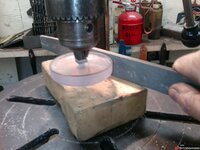
Cut a snap ring groove to locate the shaft in place.
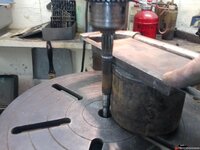
Filled the shaft splines with JB Weld (it's very low RPM and very limited use so I figured that will be OK) and filed it down to just under 9/16" diameter, the OD of the splines.
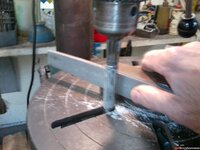
Ground down an old 1" milling machine cutter to fit in my drill press and milled down the motor end cap bushing so the plastic piece would seat against the end of the cap but still have some metal bushing for the shaft. Then I drilled out the plastic support & end cap to 9/16", assembled together for alignment
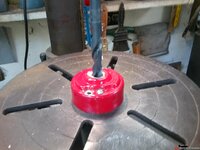
Cut off the last 5/8" of the shaft which originally was in the end cap bushing. The diameter of the next step of the shaft was perfect to file a square 3/8" socket drive end on it. Cut off the solenoid "tower" and made a little tin cover for the hole. Cut a couple 3" long pieces of 10-32 all thread to make shorter through bolts.
Here's a couple pre-assembly views as it all went together:
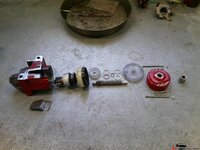
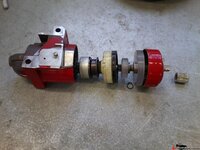
And voila! It's even already painted "Special Tool Red."
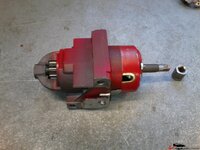
I haven't tried it on the car yet of course, but it spins and with the gear reductions of the planetaries & flywheel, I expect it will hold up & work to slowly turn the engine over.
It took me about 10 hours or so to make-- lots of pondering involved. The only thing I had to buy was a 9/16" drill bit. I'da sworn I had one, but I didn't. Now I do.
Fun project!
Gotta be a better way to turn the engine over by hand.
So I went to a starter & alternator rebuilder and got a junk starter motor for free to see if I could make one I can put a wrench on to turn over the engine by hand from below. Here's what I came up with:

Started by stripping the guts out. I replaced the solenoid throwout & spring with a piece of 5/8" heater hose to keep the gear out permanently.

I cut off the commutator & armature by sawing opposite sides to the shaft & splitting it off with hammer & chisel.

Fabbed up a planetary gear retainer & and a shaft end support bushing from some polyisocyanurate (?) plastic I had left over from the pressure brake bleeder I made a couple months ago (another fun project that came out well!).

Cut a snap ring groove to locate the shaft in place.

Filled the shaft splines with JB Weld (it's very low RPM and very limited use so I figured that will be OK) and filed it down to just under 9/16" diameter, the OD of the splines.

Ground down an old 1" milling machine cutter to fit in my drill press and milled down the motor end cap bushing so the plastic piece would seat against the end of the cap but still have some metal bushing for the shaft. Then I drilled out the plastic support & end cap to 9/16", assembled together for alignment

Cut off the last 5/8" of the shaft which originally was in the end cap bushing. The diameter of the next step of the shaft was perfect to file a square 3/8" socket drive end on it. Cut off the solenoid "tower" and made a little tin cover for the hole. Cut a couple 3" long pieces of 10-32 all thread to make shorter through bolts.
Here's a couple pre-assembly views as it all went together:


And voila! It's even already painted "Special Tool Red."

I haven't tried it on the car yet of course, but it spins and with the gear reductions of the planetaries & flywheel, I expect it will hold up & work to slowly turn the engine over.
It took me about 10 hours or so to make-- lots of pondering involved. The only thing I had to buy was a 9/16" drill bit. I'da sworn I had one, but I didn't. Now I do.
Fun project!
Last edited:

